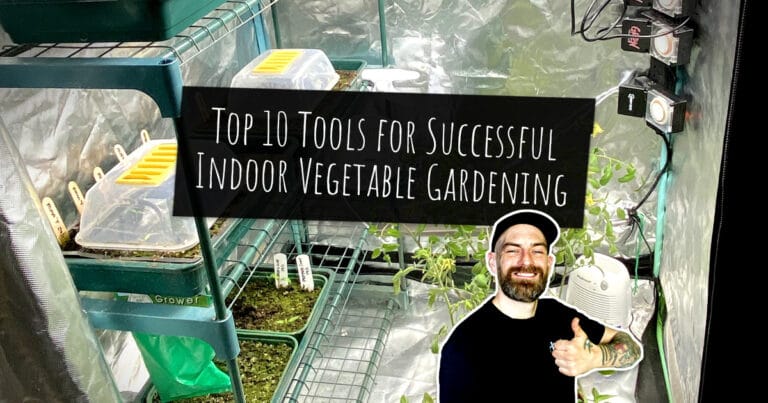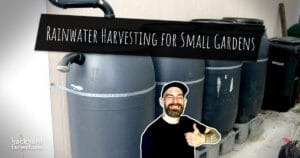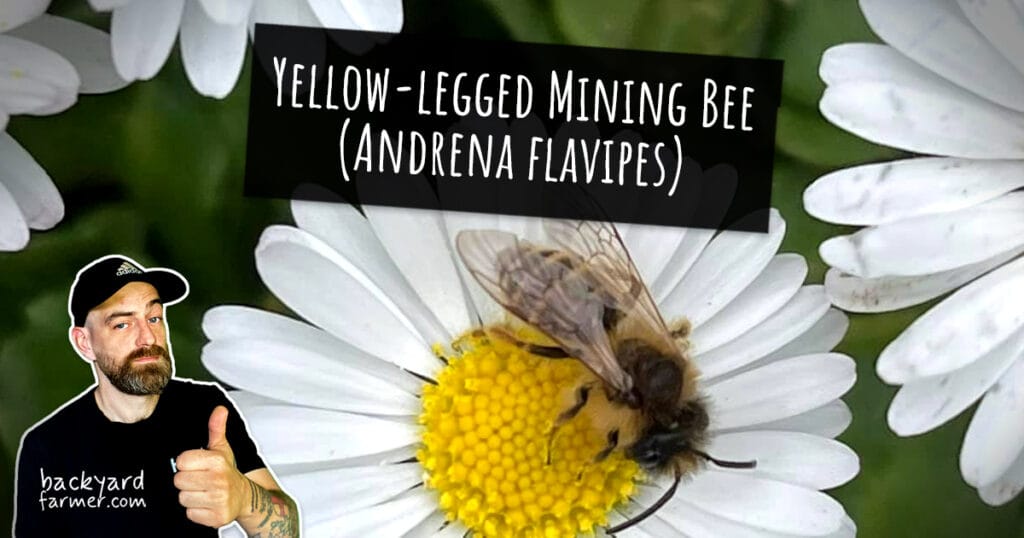Table of contents
- Introduction
- 1. Grow Lights: Mimicking Natural Sunlight
- 2. Indoor Planters and Containers: Choosing the Right Size
- 3. Potting Mix: The Foundation of Healthy Plants
- 4. Watering Tools: Ensuring Consistent Moisture
- 5. Humidity and Temperature Control Devices
- 6. Pruning Shears and Scissors: Keeping Your Plants in Shape
- 7. Plant Supports: Staking and Training Indoor Vegetables
- 8. Fertilizers and Nutrients: Feeding Your Indoor Garden
- 8. Fertilizers and Nutrients: Feeding Your Indoor Garden
- 10. Gardening Apps and Technology: Smart Gardening Solutions
- Conclusion
Introduction
Indoor vegetable gardening is a growing trend, especially for those who want to enjoy fresh produce year-round without worrying about outdoor conditions. However, achieving success in indoor gardening requires more than just seeds and soil. The right tools can make all the difference in ensuring your plants thrive. In this article, we’ll explore the top 10 tools that every indoor gardener should have in their arsenal, from grow lights to humidity monitors. Whether you’re a seasoned gardener or just starting, these tools will help you cultivate a flourishing indoor garden.
For those with limited space, you might also be interested in exploring the best indoor vegetable garden kits for small spaces to complement your gardening tools.
1. Grow Lights: Mimicking Natural Sunlight
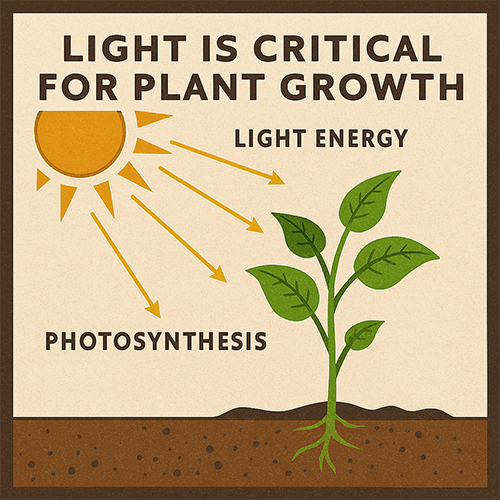
Importance of Light for Indoor Plants
Light is critical for indoor gardening because it powers photosynthesis—the process by which plants convert light into energy. Without sufficient light, indoor plants can become weak, leggy, and unproductive.
The right indoor gardening tools, such as grow lights, can replicate natural sunlight, helping your plants thrive even in low-light conditions. Understanding your plants’ light requirements is crucial for achieving success in indoor gardening.
Types of Grow Lights: LED, Fluorescent, and Incandescent
When selecting grow lights, it’s important to choose the right type to meet your indoor gardening needs. The table below summarizes the key features of each type:
| Type of Grow Light | Efficiency | Heat Emission | Lifespan | Best For | Cost |
| LED | Very High | Low | Long (up to 50,000 hours) | All stages of plant growth | High initial, low long-term |
| Fluorescent | Moderate | Moderate | Medium (10,000 – 20,000 hours) | General indoor gardening | Low |
| Incandescent | Low | High | Short (1,000 – 2,000 hours) | Not recommended | Very Low |

🌱 Recommended: Spider Farmer SF2000 LED Grow Light
This is the exact model I use in my indoor garden — efficient, full-spectrum, and perfect for small-to-medium grow spaces.
- Full-spectrum output with IR – ideal for veg & bloom stages
- Dimmable & energy-efficient (200W draw)
- Silent passive cooling – no fan noise
- My hands-on SF2000 review: https://backyard-farmer.com/spider-farmer-sf-2000-led-grow-light-review/
- Why I trust Spider Farmer: https://backyard-farmer.com/why-i-trust-spider-farmer-honest-review-of-their-lights-kits-more/
Tips for Positioning and Using Grow Lights Effectively
Proper use and positioning of grow lights are essential to maximize their benefits:
- Distance Matters: Position your grow lights at the appropriate distance from your plants to avoid issues. LED lights should be placed 12-24 inches above plants, while fluorescent lights can be closer, around 6-12 inches. Proper distance ensures that your plants receive the right amount of light without getting scorched.
- Light Duration: Most indoor vegetables require 12-16 hours of light per day to thrive. Using a timer to automate the lighting schedule can help maintain consistency and prevent light stress. Some plants also benefit from a period of darkness, so adjusting the light duration based on the specific needs of your plants is important.
- Reflective Surfaces: Maximize light efficiency by using reflective materials like mylar or aluminum foil around your plants. These surfaces help bounce light back onto the plants, reducing wasted light and improving overall growth. This simple technique can enhance the effectiveness of your indoor gardening tools.
- Regular Maintenance: Keep your grow lights clean to ensure they continue to provide optimal light. Dust and debris can block light and reduce effectiveness. Regularly check for signs of wear or reduced brightness and replace bulbs or fixtures as needed to maintain ideal growing conditions.
By understanding the importance of light and selecting the right grow lights, you can create an indoor environment that closely mimics natural sunlight. This ensures your plants have the best possible conditions to grow healthy and strong, making grow lights one of the most essential indoor gardening tools in your arsenal.
2. Indoor Planters and Containers: Choosing the Right Size
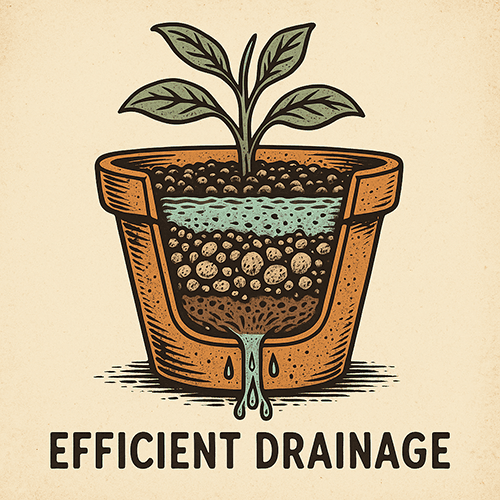
Importance of Proper Drainage and Material Choice
The choice of planters and containers is crucial for the health and growth of your indoor plants. Proper drainage is essential to prevent waterlogging, which can lead to root rot and other issues. The material of the container also plays a significant role in plant health, as it affects moisture retention, air circulation, and temperature regulation. Understanding these factors can help you select the best indoor gardening tools for your plants.
Recommended Planter Sizes for Different Vegetables
Different vegetables have varying root systems and space requirements, making it important to choose the right container size. Here’s a quick guide:
| Vegetable | Minimum Container Size | Preferred Material | Notes |
| Tomatoes | 18-24 inches deep | Plastic, Fabric | Deep root system; requires large containers. |
| Lettuce | 6-8 inches deep | Plastic, Clay | Shallow roots; works well in smaller, shallow pots. |
| Carrots | 12-14 inches deep | Fabric, Wood | Needs depth for roots; loose soil is beneficial. |
| Herbs (Basil, Parsley) | 4-6 inches deep | Clay, Plastic | Compact roots; grows well in smaller containers. |
| Peppers | 12-14 inches deep | Plastic, Fabric | Moderate depth; benefits from well-draining soil. |
Space-Saving Container Solutions for Small Indoor Gardens
For those with limited space, choosing the right containers can help maximize your indoor garden:
- Vertical Planters: These are ideal for growing multiple plants in a small footprint. They allow you to grow herbs, lettuce, or strawberries vertically, making efficient use of wall space.
- Hanging Baskets: Perfect for trailing plants like tomatoes or strawberries, hanging baskets free up floor space and add a decorative element to your indoor garden.
- Self-Watering Containers: These containers are designed with a reservoir at the bottom that allows plants to draw up water as needed, reducing the frequency of watering and ensuring consistent moisture levels.
- Fabric Pots: These lightweight, breathable pots promote air pruning of roots, leading to healthier plants. They are also easy to move and store, making them ideal for indoor gardeners with limited space.
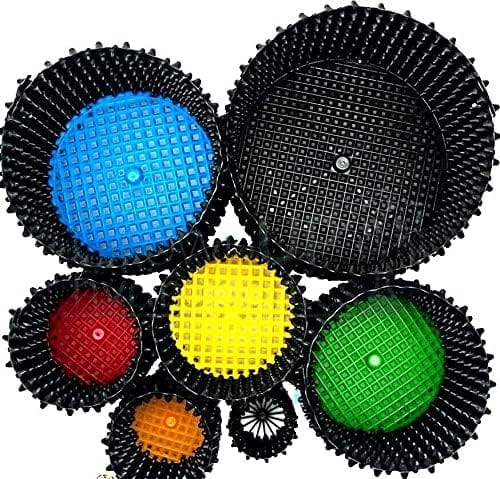
Recommended Planter: AIR POT – Amazing Roots
This high-performance container promotes healthier, faster-growing plants by improving root structure and oxygen flow. Ideal for indoor vegetables like tomatoes, lettuce, and peppers.
- Air-pruning design prevents root circling
- Enhances drainage and nutrient uptake
- Reusable and long-lasting plastic construction
🔗 Tip: These are great for both soil and hydroponic setups. I recommend them for deep-rooted veg like tomatoes and carrots, especially where drainage is key.
Tips for Choosing the Right Planter
Choosing the right planter involves considering several factors:
- Size Matters: Ensure the container is large enough to accommodate the mature size of the plant’s root system. A too-small container can stunt growth, while a too-large one may lead to water retention issues.
- Material Considerations: Plastic containers are lightweight and retain moisture well, making them suitable for most indoor plants. Clay pots, while more attractive, are porous and may require more frequent watering. Fabric pots offer excellent drainage and aeration but may dry out more quickly.
- Drainage Solutions: Always select containers with drainage holes to prevent waterlogging. If you prefer containers without holes for aesthetic reasons, consider using a layer of stones at the bottom or double-potting with an inner container that has drainage holes.
- Aesthetics and Functionality: While the function is crucial, the appearance of your planters can enhance the overall look of your indoor garden. Choose containers that complement your interior decor while still meeting the needs of your plants.
By carefully selecting the right planters and containers, you can ensure that your indoor garden thrives. Proper drainage, appropriate size, and material choice are all vital components in maintaining healthy, productive plants, making planters one of the key indoor gardening tools in your setup.
3. Potting Mix: The Foundation of Healthy Plants
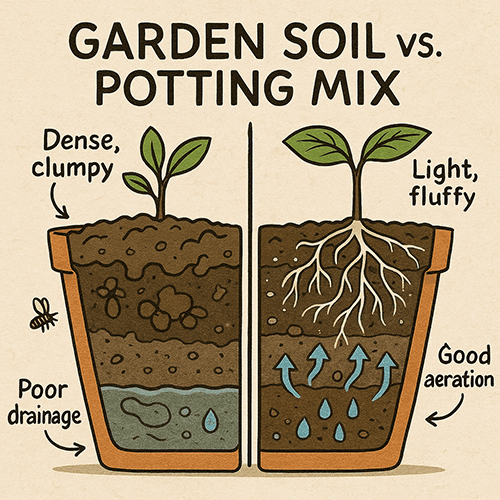
Differences Between Garden Soil and Potting Mix
Choosing the right growing medium is essential for the success of your indoor garden. While garden soil might be suitable for outdoor plants, it is often too dense for indoor containers, leading to poor drainage and root health issues.
Potting mix, on the other hand, is specifically formulated to be lighter, well-aerated, and well-draining, making it one of the most critical indoor gardening tools for your plants. Potting mixes are typically free of pathogens and pests, providing a healthier environment for your indoor plants.
Key Ingredients of a Good Potting Mix
A high-quality potting mix is composed of several key ingredients that contribute to optimal plant growth. Here’s a breakdown of the most common components:
| Ingredient | Purpose | Benefits |
| Peat Moss | Retains moisture while providing good drainage | Helps maintain a consistent moisture level |
| Perlite | Enhances aeration and prevents soil compaction | Promotes healthy root growth and prevents root rot |
| Vermiculite | Holds moisture and nutrients | Ensures a steady supply of water and nutrients |
| Coconut Coir | Sustainable alternative to peat moss | Excellent water retention and biodegradability |
| Compost | Adds organic matter and nutrients | Enriches the soil with natural fertilizers |
| Sand | Improves drainage | Prevents waterlogging in heavy soils |
DIY Potting Mix Recipes for Various Plants
Creating your own potting mix allows you to tailor the medium to the specific needs of your plants. Here are some simple DIY recipes:
- General Purpose Mix:
- 1 part peat moss or coconut coir
- 1 part perlite or vermiculite
- 1 part compost
- Ideal for most vegetables and herbs, this mix provides a balanced environment with good moisture retention and aeration.
- Cactus and Succulent Mix:
- 2 parts sand
- 1 part peat moss or coconut coir
- 1 part perlite
- Designed for plants that require excellent drainage and minimal moisture retention.
- Seed Starting Mix:
- 2 parts peat moss or coconut coir
- 1 part vermiculite
- 1 part perlite
- A light, airy mix that promotes fast germination and strong seedling development.
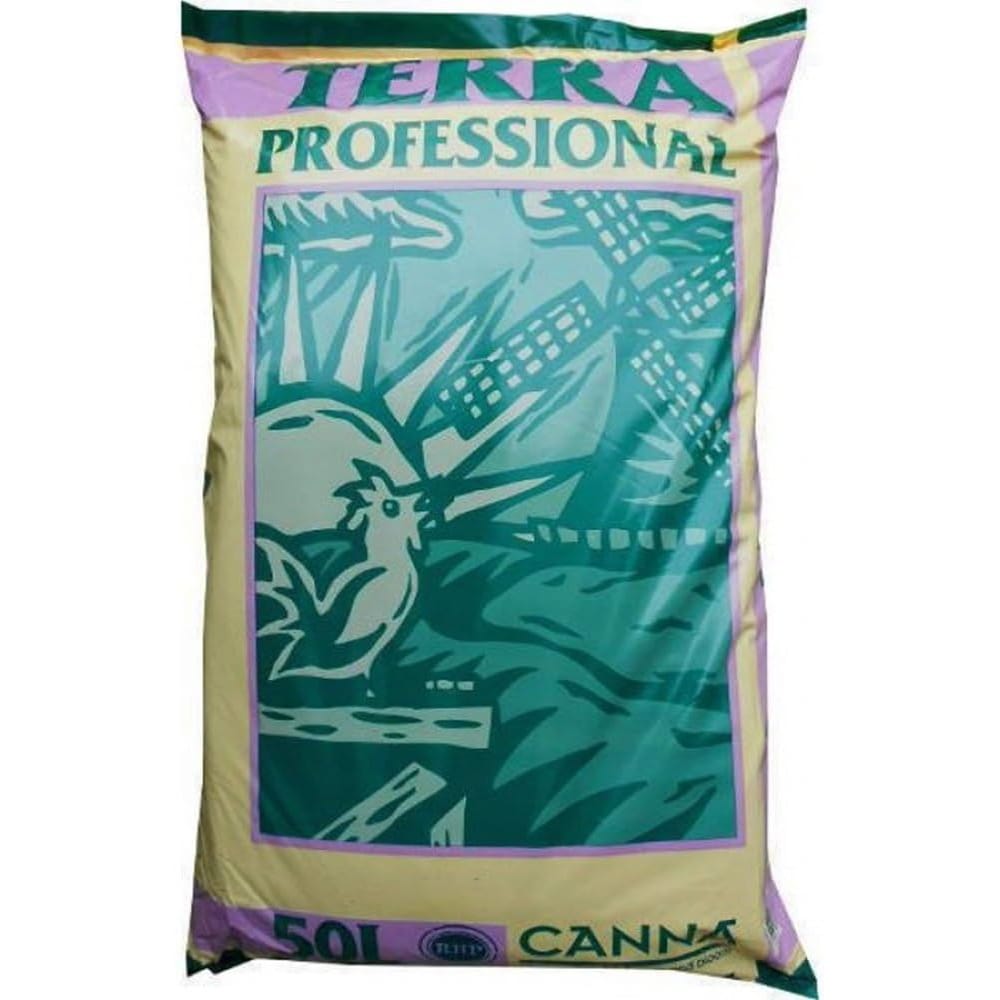
🥥 Coco Coir Mix
An eco-friendly base that improves drainage while holding moisture just enough for healthy root growth.
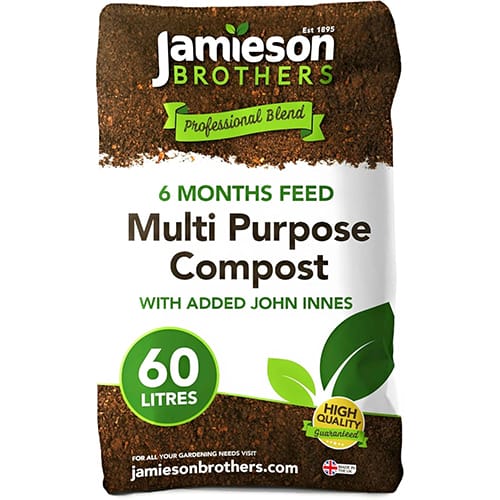
🌱 Compost
Enriches your potting mix with essential nutrients for strong early growth and long-lasting feed.

🧊 Perlite
Boosts aeration and drainage, preventing soil compaction and improving oxygen flow to the roots.
Tips for Using Potting Mix Effectively
Using potting mix effectively is key to maintaining a healthy indoor garden. Here are some tips:
- Moisture Management: Potting mixes are designed to retain moisture, but it’s still important to water your plants correctly. Ensure that the mix is moist but not waterlogged, and allow it to dry out slightly between waterings to prevent root rot.
- Fertilization: While many potting mixes contain some nutrients, they can be depleted over time. Regularly feeding your plants with a balanced fertilizer will ensure they continue to receive the nutrients they need. Consider using organic fertilizers to complement the natural components of the potting mix.
- Replenishing and Refreshing: Over time, potting mix can become compacted and lose its effectiveness. It’s a good practice to refresh the potting mix each growing season by adding fresh material or completely replacing the old mix. This helps maintain optimal conditions for root growth and nutrient absorption.
- Avoid Reusing Old Mix: While it might be tempting to reuse potting mix from previous seasons, it’s generally not recommended. Old mix can harbor pests, diseases, and depleted nutrients, which can negatively affect your new plants. If you must reuse potting mix, sterilize it first by baking it in the oven or treating it with boiling water.
By choosing the right potting mix and using it effectively, you provide a strong foundation for your indoor garden. Whether you opt for a pre-made mix or create your own, ensuring that your plants have the right environment for root growth is crucial to their overall health and productivity. Potting mix is undoubtedly one of the essential indoor gardening tools that can make or break your gardening success.
4. Watering Tools: Ensuring Consistent Moisture
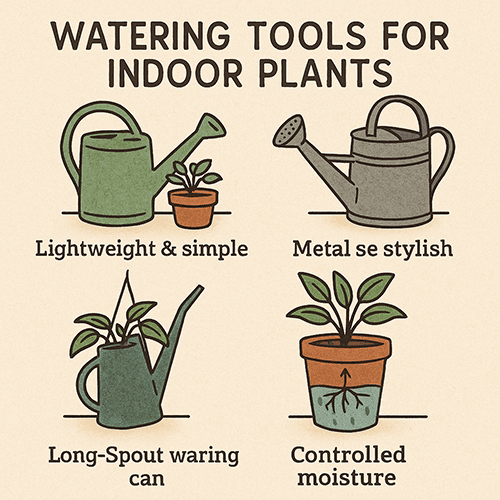
Types of Watering Cans and Their Advantages
Watering is one of the most critical aspects of indoor gardening, and the right watering tools can make all the difference in maintaining healthy plants. Watering cans come in various designs, each with its own set of advantages. Selecting the appropriate type for your indoor garden can help you manage moisture levels effectively and avoid common problems like overwatering or underwatering.
| Type of Watering Can | Material | Advantages | Best For |
| Plastic Watering Can | Lightweight, Durable | Inexpensive, lightweight, and easy to handle | Small to medium-sized indoor plants |
| Metal Watering Can | Sturdy, Long-lasting | Durable and often aesthetically pleasing | Larger indoor plants and decorative use |
| Long-Spout Watering Can | Plastic or Metal | Allows precise watering, ideal for hard-to-reach plants | Hanging plants, dense foliage areas |
| Self-Watering Can | Plastic | Provides controlled, gradual watering | Sensitive plants needing consistent moisture |
Benefits of Self-Watering Systems for Indoor Gardens
Self-watering systems are an excellent solution for gardeners who want to ensure consistent moisture levels without daily watering. These systems typically involve a reservoir that supplies water to the plants as needed, which can prevent issues like root rot caused by overwatering. Here are some key benefits:
- Consistent Moisture: Self-watering systems provide a steady supply of water, reducing the risk of underwatering or overwatering. The plant draws water from the reservoir as needed, ensuring it receives the right amount of moisture.
- Reduced Maintenance: These systems reduce the frequency of watering, making them ideal for busy gardeners or those who travel frequently. They also minimize the risk of forgetting to water your plants.
- Healthier Roots: By providing consistent moisture levels, self-watering systems encourage healthy root development. The roots are less likely to suffer from stress due to fluctuating water levels, leading to stronger, more resilient plants.
- Water Efficiency: Self-watering systems can help conserve water by minimizing evaporation and runoff. They deliver water directly to the roots, ensuring that every drop is used effectively.
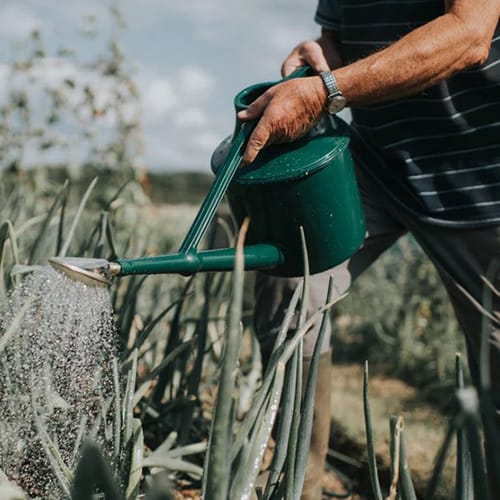
🚿 Recommended Watering Can: Haws Cradley Deluxe (1.5 Gallon)
Trusted by pros and perfectly balanced for extended use, the Haws Cradley Deluxe features a long spout and fine rose for a soft, even flow — ideal for delicate indoor plants and tight spaces.
- Precision watering with classic style
- Long reach for dense or hanging foliage
- Lightweight and durable construction
🔗 Tip: The brass rose option offers a beautifully gentle spray perfect for seedlings and herbs.
How to Avoid Overwatering and Root Rot
Overwatering is one of the most common issues faced by indoor gardeners and can lead to root rot, a condition where the roots become waterlogged and start to decay. Here are some tips to avoid overwatering:
- Use Pots with Drainage Holes: Always use containers with drainage holes to allow excess water to escape. If your pots don’t have drainage, consider double-potting with an inner pot that has holes.
- Water Only When Necessary: Check the soil moisture before watering. A good rule of thumb is to water when the top inch of soil feels dry to the touch. Overwatering occurs when you water before the soil has had a chance to dry out.
- Choose the Right Potting Mix: As discussed in the previous section, a well-draining potting mix is essential to prevent water from pooling around the roots. Potting mixes with perlite, sand, or vermiculite help improve drainage.
- Monitor Humidity Levels: High humidity can slow down the evaporation of water from the soil, leading to soggy conditions. Use a humidity monitor to keep track of the moisture levels in your growing environment, and adjust your watering schedule accordingly.
- Elevate Your Pots: Placing pots on a tray with pebbles or a plant stand can help excess water drain away from the roots, reducing the risk of waterlogging.
By using the right watering tools and following these best practices, you can maintain the optimal moisture levels for your indoor garden. Watering cans, self-watering systems, and proper drainage methods are all essential indoor gardening tools that help ensure your plants stay healthy and thrive.
5. Humidity and Temperature Control Devices
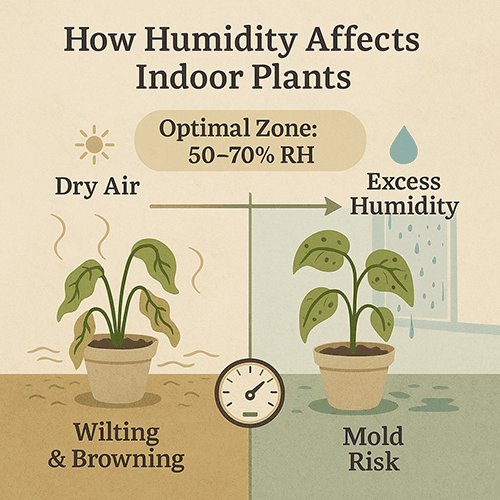
Importance of Maintaining Optimal Humidity Levels
Maintaining the right humidity levels is crucial for indoor gardening. Most indoor plants, especially vegetables, thrive in a specific range of humidity. If the air is too dry, plants may experience wilting, browning of leaf edges, and stunted growth.
On the other hand, excessive humidity can promote the growth of mold, mildew, and other pathogens, leading to plant diseases. Understanding and controlling the humidity levels in your indoor garden is essential for creating an environment where your plants can thrive.
Best Practices for Temperature Regulation in an Indoor Garden
Temperature control is equally important as humidity when it comes to indoor gardening. Each plant has a preferred temperature range that supports its growth and development. Here are some best practices for maintaining the ideal temperature in your indoor garden:
- Monitor Regularly: Use a thermometer to keep track of the temperature in your indoor garden. Ideally, most indoor vegetables prefer temperatures between 65°F and 75°F (18°C to 24°C) during the day and slightly cooler at night.
- Avoid Extreme Fluctuations: Sudden changes in temperature can stress plants, leading to poor growth or even death. Ensure that your indoor garden is not exposed to drafts, direct heat sources, or cold windows.
- Use Heating Mats for Seedlings: For plants that require a warmer soil temperature for germination, such as tomatoes and peppers, consider using heating mats. These mats provide consistent warmth to the soil, promoting faster and more reliable germination.
- Adjust Based on Plant Needs: Some plants, like leafy greens, prefer cooler temperatures, while others, like tomatoes and peppers, thrive in warmer conditions. Adjust the temperature settings or the location of your plants accordingly.
Recommended Humidifiers and Thermometers for Indoor Gardening
Using the right devices to monitor and control humidity and temperature can greatly enhance your indoor gardening success. Below is a comparison of recommended tools:
| Device | Function | Best For | Benefits |
| Digital Hygrometer | Measures humidity | All indoor gardening setups | Provides accurate humidity readings |
| Humidifier with Adjustable Settings | Increases humidity | Dry indoor environments, sensitive plants | Maintains consistent moisture levels |
| Dehumidifier | Reduces excess humidity | Humid environments, mold prevention | Prevents mold and mildew growth |
| Heating Mat | Warms soil | Seed starting, heat-loving plants | Promotes faster germination and growth |
| Thermometer with Remote Sensor | Monitors temperature remotely | Large or multi-room indoor gardens | Allows for convenient temperature tracking |
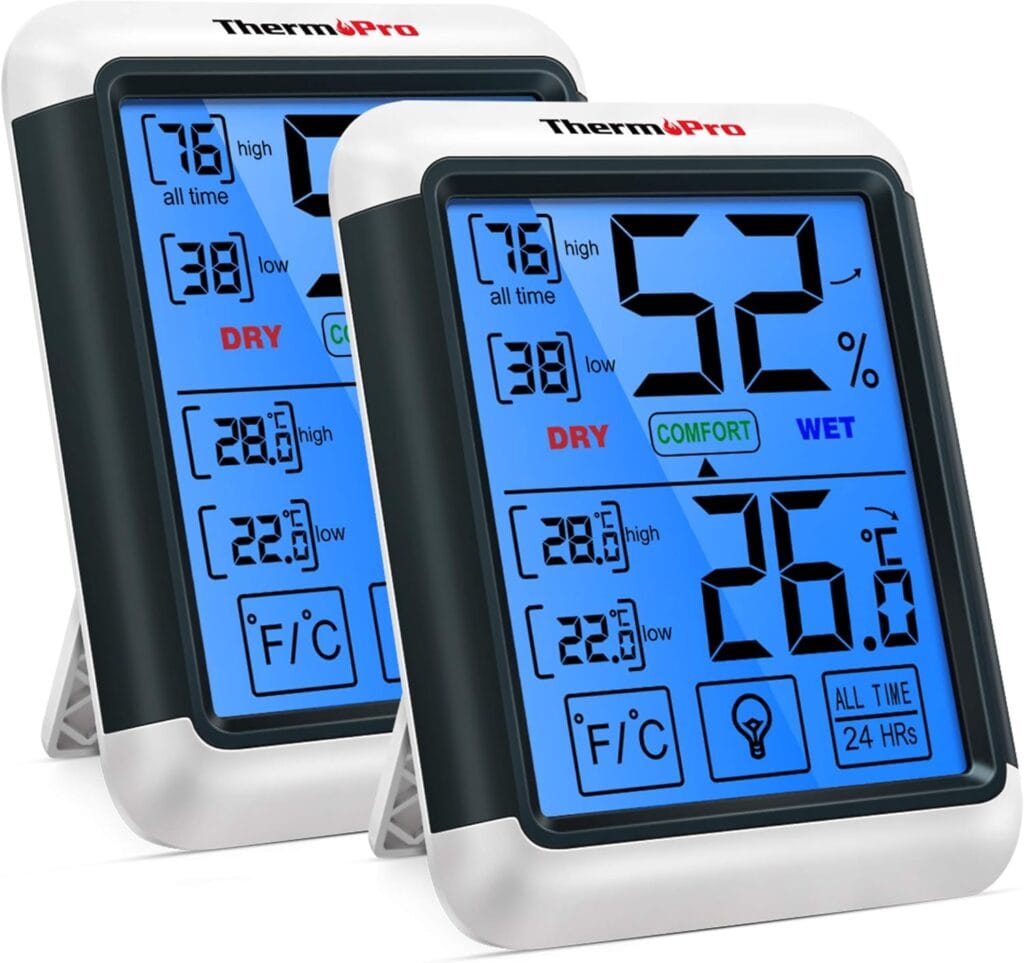
🌡️ Recommended Humidity Monitor: ThermoPro TP55 Digital Hygrometer
Take control of your indoor grow environment with the ThermoPro TP55 — a dual-pack digital monitor that accurately tracks temperature and humidity with a clear, backlit touchscreen display.
- Displays current, high/low, and comfort zone levels
- Easy-to-read interface with adjustable °C/°F
- Dual sensors: perfect for monitoring multiple grow zones
🔗 Tip: Ideal for indoor gardening setups, these devices help prevent humidity stress and improve overall plant health by keeping conditions consistent.
Tips for Managing Humidity and Temperature
Maintaining the right humidity and temperature levels requires a proactive approach. Here are some tips to help you manage these conditions effectively:
- Group Plants by Humidity Needs: Plants with similar humidity requirements should be grouped together. This makes it easier to manage the environment effectively, whether you’re adding moisture with a humidifier or reducing it with a dehumidifier.
- Use a Humidity Tray: For plants that require higher humidity, such as tropical varieties, placing a tray filled with water and pebbles under the pots can help increase the humidity around the plants.
- Ventilation: Ensure proper air circulation in your indoor garden. Good ventilation helps prevent stagnant air, which can lead to mold and mildew. Use fans if necessary to keep the air moving and maintain an even temperature throughout the space.
- Automate Your Environment: Consider using smart devices that allow you to automate humidity and temperature control. For instance, smart thermostats and humidifiers can adjust settings based on real-time data, ensuring your plants are always in an optimal environment.
By using the right humidity and temperature control devices and following these best practices, you can create an ideal growing environment for your indoor garden. These tools are essential indoor gardening tools that help you maintain a stable and healthy environment, ensuring your plants thrive.
6. Pruning Shears and Scissors: Keeping Your Plants in Shape
Why Regular Pruning is Essential for Indoor Plants
Pruning is a crucial practice for maintaining the health and productivity of indoor plants. Regular pruning helps to remove dead or diseased parts of the plant, encouraging new growth and improving air circulation. It also allows you to shape the plant, control its size, and promote better flowering or fruiting. Without proper pruning, plants can become overgrown, leading to poor light penetration and increased susceptibility to pests and diseases.
Types of Pruning Tools and Their Uses
Choosing the right pruning tool is essential for performing precise and effective cuts. Here’s a look at the most common types of pruning tools and their specific uses:
| Tool | Best For | Advantages | Ideal Plants |
| Bypass Pruners | General pruning | Clean cuts, ideal for living stems | Herbs, small vegetables, flowers |
| Anvil Pruners | Cutting dead wood | Strong, crushing action, effective on tough branches | Woody plants, large stems |
| Pruning Scissors | Precision trimming | Small, lightweight, perfect for delicate tasks | Herbs, flowers, small indoor plants |
| Loppers | Cutting thick branches | Long handles for leverage, cuts through thicker stems | Larger indoor trees, shrubs |
| Pruning Saw | Removing larger branches | Sharp blade for cutting larger, tougher branches | Indoor fruit trees, large woody plants |
Tips for Effective Pruning and Shaping of Plants
Proper pruning techniques are essential for the health and aesthetics of your indoor plants. Here are some tips to ensure you’re pruning effectively:
- Use the Right Tool for the Job: Always choose the appropriate tool based on the size and type of the plant you’re pruning. Using the wrong tool can damage the plant and make the pruning process more difficult.
- Make Clean Cuts: Ensure that your pruning tools are sharp. Clean cuts heal faster and reduce the risk of disease. Avoid tearing or crushing the plant tissue, as this can lead to infection.
- Prune at the Right Time: The best time to prune most indoor plants is during their dormant season or just before new growth starts in the spring. However, dead or diseased parts should be removed as soon as they are noticed.
- Follow the 3 D’s: When pruning, focus on removing dead, diseased, or damaged parts of the plant first. This promotes healthier growth and prevents the spread of disease.
- Shape as Needed: Pruning is not just about removing unwanted growth; it’s also an opportunity to shape your plants. Regularly trim back overgrown branches to maintain a desirable size and shape, especially in small indoor spaces.
- Sanitize Tools: To prevent the spread of diseases between plants, always sanitize your pruning tools before and after use. Wipe the blades with rubbing alcohol or a solution of bleach and water.
Best Practices for Maintaining Pruning Tools
Maintaining your pruning tools is just as important as using them correctly. Here’s how to keep them in top condition:
- Keep Tools Sharp: Regularly sharpen your pruning tools to ensure clean cuts. Dull blades can crush plant tissue and lead to poor healing.
- Oil the Blades: After cleaning, apply a thin layer of oil to the blades to prevent rust and keep them moving smoothly.
- Store Properly: Store your tools in a dry place, ideally hanging up, to avoid moisture buildup and rust. Keeping tools in a case or toolbox can also protect the blades from damage.
- Inspect Regularly: Check your tools regularly for signs of wear and tear. Replace any damaged parts, such as springs or screws, to ensure they remain effective.
By selecting the right pruning tools and using them correctly, you can maintain the health and appearance of your indoor plants. Regular pruning helps control plant size, encourages new growth, and prevents disease, making pruning shears and scissors indispensable indoor gardening tools.
7. Plant Supports: Staking and Training Indoor Vegetables
Benefits of Using Stakes, Trellises, and Cages
Supporting your plants with stakes, trellises, or cages is essential for indoor vegetable gardening, particularly for vining plants and those that bear heavy fruits. These plant supports help keep plants upright, prevent breakage, and allow for better air circulation, reducing the risk of disease. They also make harvesting easier and more efficient by keeping fruits and vegetables off the ground.
How to Support Climbing and Vining Vegetables
Climbing and vining vegetables, such as tomatoes, beans, and cucumbers, need sturdy supports to grow vertically. Here’s how to effectively support these plants:
- Stakes: Simple and effective, stakes are ideal for supporting single-stem plants like tomatoes and peppers. Drive the stake into the soil near the plant and tie the stem loosely to the stake with garden twine or soft plant ties, ensuring not to damage the stem.
- Trellises: Trellises are perfect for vining plants like beans and peas. These structures provide a vertical surface for plants to climb, maximizing space and improving air circulation. Attach the plants to the trellis as they grow using soft ties, ensuring that they are not constricted.
- Cages: Tomato cages or similar structures are excellent for plants that need support on all sides. They prevent sprawling and keep the plants contained. Simply place the cage over the young plant and guide the stems through the openings as the plant grows.
DIY Plant Support Ideas for Indoor Use
If you’re looking for budget-friendly or space-saving plant support solutions, consider these DIY ideas:
- Bamboo Stakes: Bamboo stakes are inexpensive, lightweight, and easy to use. They can be arranged in a teepee shape for plants like beans or used individually for plants like tomatoes.
- String Trellis: Create a simple trellis using string or twine. Attach one end to a hook in the ceiling or a wall-mounted support, and tie the other end to a stake in the pot. This is perfect for lightweight vines like peas.
- Recycled Materials: Use recycled materials like old ladders, wooden pallets, or even a sturdy mesh from a used screen door as a trellis. These items can be repurposed creatively to provide support for your indoor garden.
Tips for Effective Plant Training
Training your plants to grow in the direction you want is crucial for maximizing space and ensuring healthy growth. Here’s how to train your indoor vegetables effectively:
- Start Early: Begin training plants while they are young and more flexible. This makes it easier to guide their growth and prevent damage to the stems.
- Tie Gently: Use soft materials like cloth strips, garden twine, or plant ties to secure the plant to the support. Avoid tying too tightly, as this can damage the plant.
- Regular Adjustments: As your plants grow, regularly check and adjust their ties to avoid constriction. Continue guiding the plants along their supports to ensure they follow the desired path.
- Prune for Shape: Regular pruning helps manage the plant’s growth and encourages it to focus energy on developing strong stems and producing fruit. Prune any wayward shoots that don’t conform to the desired growth pattern.
- Rotate for Light: If your indoor garden relies on natural light, rotate the plants regularly to ensure even light exposure on all sides. This prevents the plants from leaning towards the light source and encourages upright growth.
By using the right plant supports and training techniques, you can ensure that your indoor vegetables grow strong, healthy, and productive. Staking, trellising, and using cages are essential indoor gardening tools that help manage plant growth, prevent damage, and make the most of your indoor gardening space.
8. Fertilizers and Nutrients: Feeding Your Indoor Garden
Understanding the Nutritional Needs of Indoor Plants
Indoor plants have specific nutritional needs that must be met to ensure healthy growth, vibrant foliage, and productive yields. Unlike outdoor plants, which can draw nutrients from the soil, indoor plants rely heavily on the nutrients provided through fertilizers. These nutrients are essential for various plant functions, including root development, flower and fruit production, and overall plant health. Understanding the basics of plant nutrition is crucial for maintaining a thriving indoor garden.
Types of Fertilizers: Organic vs. Synthetic
Fertilizers are available in two main types: organic and synthetic. Each type has its own advantages and is suitable for different gardening needs. Here’s a comparison of the two:
| Type of Fertilizer | Composition | Advantages | Best For |
| Organic | Derived from natural sources (compost, manure, bone meal) | Improves soil structure, promotes long-term soil health | Organic gardening, slow-release nutrition |
| Synthetic | Chemically manufactured, contains precise nutrient ratios | Fast-acting, easy to measure and apply | Quick growth, targeted nutrient deficiencies |
For more detailed information on the benefits of organic versus synthetic fertilizers, you can visit the Royal Horticultural Society’s guide on fertilizers.
Tips for Fertilizing Indoor Vegetable Plants Effectively
Fertilizing indoor plants requires careful consideration of the type of plant, its growth stage, and the environment in which it’s growing. Here are some tips for effective fertilization:
- Follow the Label Instructions: Always follow the recommended dosage and application frequency provided on the fertilizer packaging. Over-fertilizing can lead to nutrient burn, which damages plants and can inhibit growth.
- Match Fertilizer to Plant Needs: Use a balanced fertilizer (e.g., 10-10-10) for general feeding, but consider specialized formulas for specific needs. For example, a higher phosphorus content (the middle number in the N-P-K ratio) can promote flowering and fruiting, which is ideal for indoor vegetables like tomatoes and peppers.
- Fertilize During Active Growth: Indoor plants typically require more nutrients during their active growing season, which is usually in spring and summer. Reduce or stop fertilizing during the winter when many plants enter a dormant phase.
- Use Liquid Fertilizers for Easy Application: Liquid fertilizers are ideal for indoor plants because they are easy to apply and can be quickly absorbed by the roots. They can also be used as foliar sprays, where nutrients are absorbed through the leaves.
- Consider Slow-Release Fertilizers: Slow-release fertilizers are convenient for indoor gardeners because they release nutrients gradually over time, reducing the need for frequent feeding. These are particularly useful for plants that need consistent, long-term nutrition.
- Monitor for Nutrient Deficiencies: Watch for signs of nutrient deficiencies, such as yellowing leaves (nitrogen deficiency), poor flowering (phosphorus deficiency), or weak stems (potassium deficiency). If you notice these signs, adjust your fertilization routine accordingly.
Organic Fertilizer Options
For those who prefer to use organic fertilizers, here are some popular options and their benefits:
- Compost: Rich in organic matter and a broad spectrum of nutrients, compost improves soil health and structure over time. It’s ideal for enriching potting mixes and providing slow-release nutrients.
- Worm Castings: A potent organic fertilizer, worm castings are rich in beneficial microorganisms and essential nutrients. They can be mixed into the soil or used as a top dressing for continuous feeding.
- Bone Meal: High in phosphorus, bone meal is excellent for promoting root development and flowering. It’s best applied during planting or as a side dressing during the growing season.
- Fish Emulsion: A liquid fertilizer derived from fish, it provides a balanced supply of nutrients and is particularly high in nitrogen. It’s useful for promoting lush, green growth in leafy vegetables.
- Seaweed Extract: This liquid fertilizer is packed with trace minerals and natural growth hormones. It can enhance overall plant health and improve resistance to stress.
Nutrient Management Tips
Managing nutrients in an indoor garden involves more than just applying fertilizers. Here are some additional tips to ensure your plants get the nutrients they need:
- Test the Soil: Periodically test the soil in your containers to check pH levels and nutrient content. This can help you make informed decisions about fertilizer application and prevent over-fertilization.
- Flush the Soil: Over time, salts from fertilizers can build up in the soil, leading to nutrient imbalances. Periodically flushing the soil with water can help remove excess salts and keep the soil healthy.
- Rotate Fertilizers: To prevent nutrient imbalances, consider rotating different types of fertilizers throughout the growing season. This ensures that your plants receive a wide range of nutrients.
- Use Mulch: Applying a layer of organic mulch, such as compost or straw, can help retain moisture, regulate soil temperature, and gradually add nutrients as it decomposes.
By understanding the nutritional needs of your plants and using the right fertilizers, you can ensure that your indoor garden thrives. Whether you choose organic or synthetic options, fertilization is a key component of indoor gardening success and one of the essential indoor gardening tools to master.
8. Fertilizers and Nutrients: Feeding Your Indoor Garden
Understanding the Nutritional Needs of Indoor Plants
Indoor plants have specific nutritional needs that must be met to ensure healthy growth, vibrant foliage, and productive yields. Unlike outdoor plants, which can draw nutrients from the soil, indoor plants rely heavily on the nutrients provided through fertilizers. These nutrients are essential for various plant functions, including root development, flower and fruit production, and overall plant health. Understanding the basics of plant nutrition is crucial for maintaining a thriving indoor garden.
Types of Fertilizers: Organic vs. Synthetic
Fertilizers are available in two main types: organic and synthetic. Each type has its own advantages and is suitable for different gardening needs. Here’s a comparison of the two:
| Type of Fertilizer | Composition | Advantages | Best For |
| Organic | Derived from natural sources (compost, manure, bone meal) | Improves soil structure, promotes long-term soil health | Organic gardening, slow-release nutrition |
| Synthetic | Chemically manufactured, contains precise nutrient ratios | Fast-acting, easy to measure and apply | Quick growth, targeted nutrient deficiencies |
Tips for Fertilizing Indoor Vegetable Plants Effectively
Fertilizing indoor plants requires careful consideration of the type of plant, its growth stage, and the environment in which it’s growing. Here are some tips for effective fertilization:
- Follow the Label Instructions: Always follow the recommended dosage and application frequency provided on the fertilizer packaging. Over-fertilizing can lead to nutrient burn, which damages plants and can inhibit growth.
- Match Fertilizer to Plant Needs: Use a balanced fertilizer (e.g., 10-10-10) for general feeding, but consider specialized formulas for specific needs. For example, a higher phosphorus content (the middle number in the N-P-K ratio) can promote flowering and fruiting, which is ideal for indoor vegetables like tomatoes and peppers.
- Fertilize During Active Growth: Indoor plants typically require more nutrients during their active growing season, which is usually in spring and summer. Reduce or stop fertilizing during the winter when many plants enter a dormant phase.
- Use Liquid Fertilizers for Easy Application: Liquid fertilizers are ideal for indoor plants because they are easy to apply and can be quickly absorbed by the roots. They can also be used as foliar sprays, where nutrients are absorbed through the leaves.
- Consider Slow-Release Fertilizers: Slow-release fertilizers are convenient for indoor gardeners because they release nutrients gradually over time, reducing the need for frequent feeding. These are particularly useful for plants that need consistent, long-term nutrition.
- Monitor for Nutrient Deficiencies: Watch for signs of nutrient deficiencies, such as yellowing leaves (nitrogen deficiency), poor flowering (phosphorus deficiency), or weak stems (potassium deficiency). If you notice these signs, adjust your fertilization routine accordingly.
Organic Fertilizer Options
For those who prefer to use organic fertilizers, here are some popular options and their benefits:
- Compost: Rich in organic matter and a broad spectrum of nutrients, compost improves soil health and structure over time. It’s ideal for enriching potting mixes and providing slow-release nutrients.
- Worm Castings: A potent organic fertilizer, worm castings are rich in beneficial microorganisms and essential nutrients. They can be mixed into the soil or used as a top dressing for continuous feeding.
- Bone Meal: High in phosphorus, bone meal is excellent for promoting root development and flowering. It’s best applied during planting or as a side dressing during the growing season.
- Fish Emulsion: A liquid fertilizer derived from fish, it provides a balanced supply of nutrients and is particularly high in nitrogen. It’s useful for promoting lush, green growth in leafy vegetables.
- Seaweed Extract: This liquid fertilizer is packed with trace minerals and natural growth hormones. It can enhance overall plant health and improve resistance to stress.
Nutrient Management Tips
Managing nutrients in an indoor garden involves more than just applying fertilizers. Here are some additional tips to ensure your plants get the nutrients they need:
- Test the Soil: Periodically test the soil in your containers to check pH levels and nutrient content. This can help you make informed decisions about fertilizer application and prevent over-fertilization.
- Flush the Soil: Over time, salts from fertilizers can build up in the soil, leading to nutrient imbalances. Periodically flushing the soil with water can help remove excess salts and keep the soil healthy.
- Rotate Fertilizers: To prevent nutrient imbalances, consider rotating different types of fertilizers throughout the growing season. This ensures that your plants receive a wide range of nutrients.
- Use Mulch: Applying a layer of organic mulch, such as compost or straw, can help retain moisture, regulate soil temperature, and gradually add nutrients as it decomposes.
By understanding the nutritional needs of your plants and using the right fertilizers, you can ensure that your indoor garden thrives. Whether you choose organic or synthetic options, fertilization is a key component of indoor gardening success and one of the essential indoor gardening tools to master.
10. Gardening Apps and Technology: Smart Gardening Solutions
Overview of the Best Gardening Apps for Indoor Gardeners
Technology has revolutionized indoor gardening, making it easier than ever to monitor and manage your plants. Gardening apps can help you track plant health, manage watering schedules, and even identify pests. Here are some of the top gardening apps that can enhance your indoor gardening experience:
- PlantSnap: An app that helps you identify plants, flowers, and trees instantly using your smartphone’s camera. It’s particularly useful for gardeners who want to know more about the plants in their indoor garden.
- Garden Answers: This app allows you to ask questions and get expert advice on plant care, pest control, and disease management. It also includes a plant identification feature.
- Blossom: A comprehensive gardening app that provides care reminders, plant identification, and personalized advice based on your specific plants and location. It’s ideal for managing multiple plants in your indoor garden.
- Florish: Designed for indoor gardening, Florish offers tips on how to care for your specific plants, tracks their growth, and even provides environmental feedback based on your plant’s needs.
- My Garden: An app from the National Gardening Association that helps you plan and track your garden. It includes a plant database, gardening tips, and a journal feature for recording your gardening activities.
How Technology Can Help Monitor Plant Health
In addition to apps, smart technology devices can significantly enhance your indoor gardening by providing real-time data and automated care for your plants. Here’s how technology can help monitor and improve plant health:
- Smart Sensors: Devices like the Parrot Flower Power or Xiaomi Plant Monitor can be placed in the soil to measure moisture, light, temperature, and fertilizer levels. They send real-time data to your smartphone, helping you adjust care as needed.
- Automated Watering Systems: Smart watering systems like Rachio or Moistenland allow you to control watering schedules remotely via an app. These systems ensure that your plants receive the right amount of water at the right time, reducing the risk of over- or under-watering.
- Grow Lights with Timers: Smart grow lights can be programmed to turn on and off at specific times, ensuring your plants receive the correct amount of light each day. Some systems, like Philips Hue, can be controlled via smartphone apps for added convenience.
- Climate Control Devices: Smart thermostats and humidifiers can help maintain optimal temperature and humidity levels in your indoor garden. Devices like Nest Thermostat or Dyson Humidifier can be controlled remotely and adjusted based on real-time data.
Recommendations for Gardening Gadgets and Sensors
Here’s a comparison of some popular gardening gadgets and sensors that can make indoor gardening more efficient and effective:
| Device/Gadget | Function | Best For | Benefits |
| Smart Soil Sensor | Monitors soil moisture, temperature, light | All indoor plants | Provides real-time data to optimize plant care |
| Automated Watering System | Controls watering schedules remotely | Busy gardeners, vacation periods | Ensures consistent watering, prevents over/under-watering |
| Smart Grow Lights | Programmable light schedules | Light-sensitive plants | Automates light exposure, improves growth |
| Smart Thermostat | Regulates temperature remotely | Maintaining optimal growing conditions | Ensures consistent temperature, energy-efficient |
| Air Quality Monitor | Measures humidity, CO2 levels | Plants sensitive to air quality (e.g., ferns) | Helps maintain healthy air quality for plants |
Benefits of Integrating Technology into Indoor Gardening
Integrating technology into your indoor gardening routine offers several benefits:
- Convenience: Automated systems and smart devices reduce the amount of manual labor involved in gardening, making it easier to manage your plants, especially if you have a busy schedule or travel frequently.
- Precision: Smart sensors and automated systems provide precise data and control, allowing you to create the perfect environment for your plants. This precision can lead to healthier plants and higher yields.
- Data-Driven Insights: Many apps and devices collect data over time, helping you understand patterns in your plant’s growth and environment. This data can be invaluable for fine-tuning your gardening practices and improving results.
- Remote Management: With smart devices, you can monitor and manage your garden from anywhere, ensuring that your plants are always well-cared for, even when you’re not at home.
- Increased Success Rate: By optimizing conditions and providing consistent care, technology can significantly increase the success rate of your indoor garden, leading to healthier, more productive plants.
Tips for Choosing the Right Technology
When selecting gardening technology and apps, consider the following tips:
- Assess Your Needs: Start by identifying the specific needs of your indoor garden. Do you need help with watering, lighting, or monitoring plant health? Choose devices and apps that address these specific areas.
- Compatibility: Ensure that the devices and apps you choose are compatible with each other and with your existing technology. For example, if you use a particular smart home system, look for gardening gadgets that can integrate seamlessly with it.
- Ease of Use: Choose technology that is user-friendly and easy to set up. Complicated devices can be frustrating and may not provide the benefits you’re looking for.
- Budget: Technology for indoor gardening can range from affordable to high-end. Determine your budget and choose devices that offer the best value for your money while meeting your gardening needs.
- Research Reviews: Before purchasing, read reviews and do your research to ensure the technology has a good track record of reliability and customer satisfaction.
By integrating the right technology and using the best gardening apps, you can take your indoor gardening to the next level. These smart indoor gardening tools provide the data, precision, and automation needed to optimize plant care and enhance the overall gardening experience.
Conclusion
Indoor vegetable gardening is a rewarding hobby that allows you to enjoy fresh, homegrown produce year-round, no matter the weather outside. However, success in this endeavor requires the right tools, knowledge, and consistent care.
Key Takeaways:
- Essential Tools: From grow lights to containers, each tool plays a crucial role in the health and productivity of your plants.
- Plant Care Basics: Understanding and managing lighting, temperature, humidity, and nutrients are vital to creating a thriving indoor garden.
- Smart Technology: Incorporating gardening apps and smart devices can simplify your gardening routine, offering convenience and precision.
- Regular Maintenance: Tools like pruning shears and plant supports help maintain plant health and shape, ensuring your garden stays manageable and productive.
Action Steps:
- Equip Yourself: Gather the necessary tools and technology that suit your indoor gardening needs.
- Plan and Monitor: Carefully plan your garden layout, monitor plant health regularly, and adjust care as needed.
- Start Growing: Whether you’re planting your first seed or expanding your indoor garden, use the insights and tips provided to ensure success.
By carefully planning, consistently caring for your plants, and utilizing modern tools and technology, you can cultivate a flourishing indoor vegetable garden. Start your journey today, and soon you’ll be enjoying the fruits (and vegetables!) of your labor.
